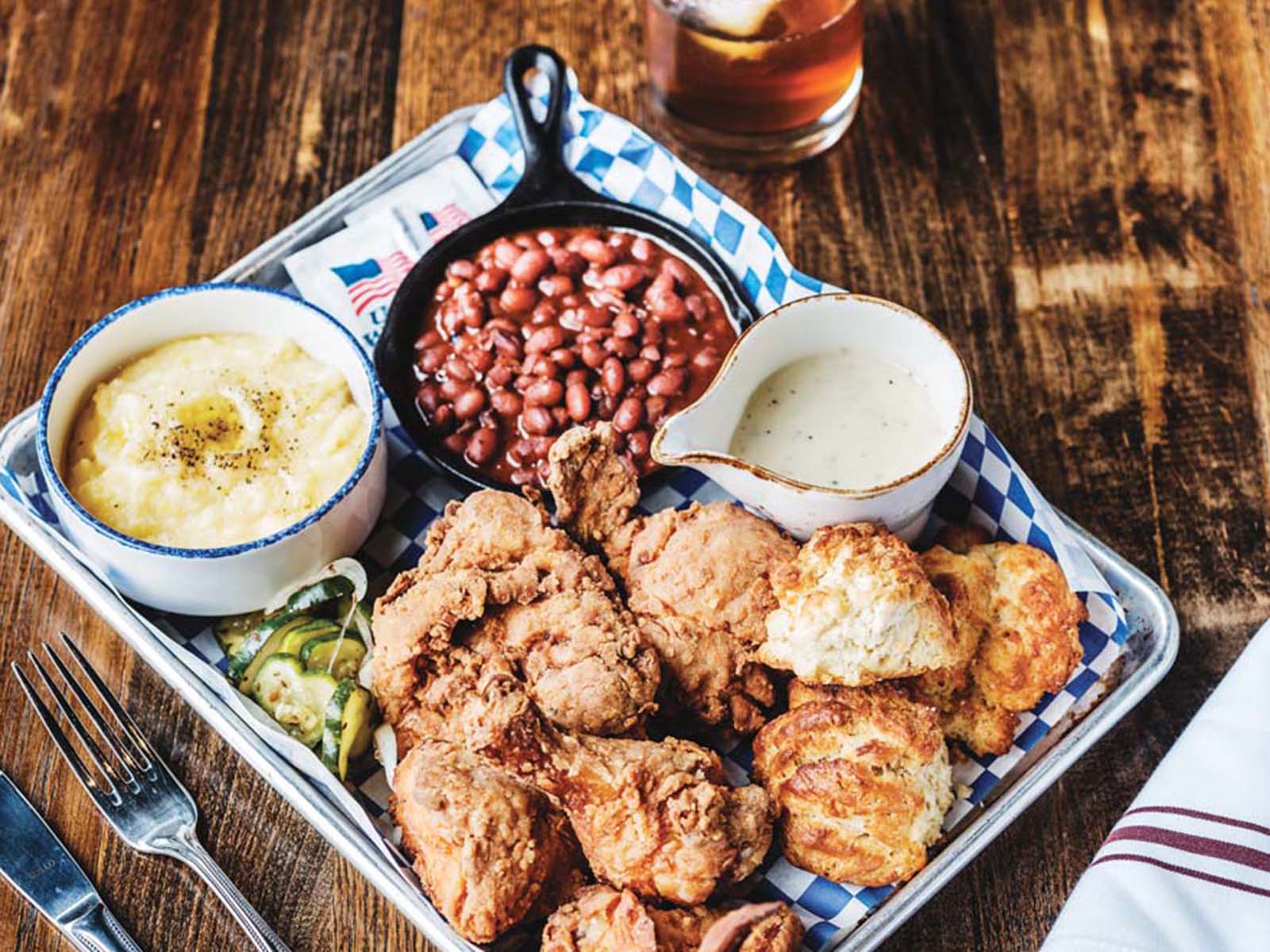The Local newsletter is your free, daily guide to life in Colorado. For locals, by locals.
Julep
3 Stars
- The Draw:
- Nose-to-tail Southern cooking
- The Drawback:
- A few dishes don’t reach the high bar set by the kitchen’s best
- Don’t Miss:
- Butcher’s daily special, biscuits and gravy, pork-and-oyster sausage, anything deep-fried, the sorghum old fashioned
When I first baked biscuits in Alabama, where I lived before coming to Colorado, I learned that the South’s beloved White Lily flour has a spooky texture, fine as talcum. In my hands (guided by an expert teacher), it yielded biscuits with an irregular, plopped-down shape and a texture that was as much pillowy as flaky. I also learned that a properly made White Lily biscuit is “praise Jesus” food, even for a nonbeliever.
One recent Sunday morning, I was put in a hallelujah mood when three of the genuine articles—same form, same texture—were served to me at Julep on Larimer Street, along with two just-so over-easy eggs and an abundance of milk gravy. The gravy, like the biscuits, was exemplary—thick but not to the point of congealing, with a nice kick from a good measure of freshly ground black pepper.
At its finest, Julep does not simply gesture at the easily imitated forms of Southern cooking (shrimp and grits, say, or those biscuits and gravy); it nails the foundational details. Florida-raised chef-owner Kyle Foster toured the region with his wife and business partner, Katy, before opening Julep in February. Their research paid off.

Kyle calls Julep a “sophisticated” Southern restaurant—a dangerous word when self-applied, often meaning “not all that sophisticated”—but in practice, he takes a high/low approach. His menu flirts with the fanciness of a white-tablecloth Atlanta eatery on one hand (a May dish of lavender-rubbed lamb with succotash, Anson Mills grits, and blueberry mustard) and your basic cinder block cook shack on the other (scrapple fries). This is defensible, as Southerners pride themselves on stepping out for an elegant Friday dinner while also knowing which back-route gas station will, the next morning, serve the finest boiled peanuts en route to the ’Bama game in Tuscaloosa.
So, let’s begin at the low end with those scrapple fries, which are diabolical sticks of cornmeal, buckwheat flour, and pork flesh, aggressively deep-fried until all that’s left is a crispy lipid superstructure supporting little morsels of meat, served in a bright paper cone. Registered dietitians spin in their graves as you eat these things, but you can’t stop eating these things. My only complaint is that the accompanying mushroom ketchup was so nondescript I couldn’t sort out its ingredients. My only question is how this dish can be considered properly Southern, seeing as scrapple is a sort of degenerate meatloaf from Pennsylvania.
What is Southern about this dish is the masterful frying, an art that many lesser kitchens fumble but Julep gets right. Kyle, the former charcuterie man at Colt & Gray who also worked at meat-centric Rebel Restaurant (now in its grave), is obviously a student of the fry-station art. He’s also a nose-to-tail butchery evangelist. I don’t know how much work is involved in deboning a pig’s tail, but Kyle did it one night for Julep’s butcher’s special, offering crisp-skinned slices on a base of citrus-tinged mashed plantain. The latter again shows that Kyle is not preaching strictly soul-food Southern; if he were, he’d have used sweet potatoes. But the mash was so tender and savory that I didn’t much care.

Others things the Julep kitchen gets right: A Colby Jack riff on Mornay sauce atop the brunch-time Kentucky Hot Brown sandwich was delicious, cheesy, and decadent but not heavy; it came with bacon and succulent smoked turkey on a briochelike slice of Pullman bread. A dollop of tomato jam on top added a clean cut of acid. At dinner, a sausage of pork and oysters was smooth and soft, like the best weisswurst ever. And a bowl of noodles this past spring with raw egg yolk, fresh peas, and country ham was very much in the tradition of Southern comfort.
Kyle simultaneously showcases his subtle side—one might say, his sophistication—with items like the blueberry mustard on the aforementioned (and sadly retired from the menu) lamb plate. It was only faintly sweet, and the blueberries had been lightly poached but not turned to mush. Their mild berry flavor, steeped into a demi-glace, resulted in a sauce that reminded me of Frank Stitt’s deft Southern/French cooking at Highlands Bar & Grill (which won the James Beard Foundation Award for outstanding restaurant in May) in Birmingham, Alabama. The lamb was cooked to a perfect rare, as ordered, and the creamy grits would pass muster in Charleston, South Carolina.

My admiration extends to the bar as well, especially regarding its cognac-heavy version of the French 75 cocktail, which moves that refresher into new territory, adding more weight and intensity. The sorghum old fashioned, made with black walnut bitters, is a delightfully full-octane sipper, and at brunch, I was happy with a glass of milk punch, a drink that’s like a fizz-free, boozy New York egg cream.
Julep’s desserts are also worth saving room for. The pecan sandies (now off the menu) were crunchy, buttery, and irresistible. Cornmeal pound cake with poppy seed ice cream and rhubarb was almost charred (in a good way) with a crumb that was a bit gritty (again, in a good way).
Still, there were things the kitchen got wrong. Julep’s smoked chicken with Alabama-style white barbecue sauce was overcooked and under-smoked, its sauce was too vinegary, and the bird was served as a plated entrée when a soft-bun sandwich is the proper way to go. The spring succotash that came with the otherwise faultless lamb was too much about chunky carrots and celery rather than lima beans and sweet corn—succotash is one country dish that doesn’t benefit from citification. A plate of fire-roasted oysters with smoked tallow sofrito was a bland disappointment. I was excited to try the appetizer of radishes and brown butter—an expert colleague had tasted a very good version at Denver’s Cochon555 competition, where Kyle won the top prize this summer—but the dish I was served tasted like radishes on top of Key lime pie filling, with no evidence of toasty milk solids from the brown butter.

I was also unimpressed with Julep’s decor. Despite a few genteel touches—a green velvet banquette backed by flowery wallpaper and a pleasant granite-topped wood bar well-stocked with brown liquors, a good place to linger on a stool—the room defaults to RiNo Proto-Garage Industrial, lacking true charm where charm would be appropriate. Of the service, I felt the same: It was friendly and competent, but not memorable.
But don’t let those critiques keep you from Julep; the Fosters have created something important. Although I wouldn’t trade away the Pan-Asian and Pan-Latin cooking going on in Denver right now, Julep reminds us that there are culinary styles closer to home we also need to celebrate. Praise the Lord—and pass the milk gravy.









